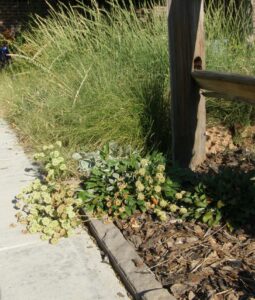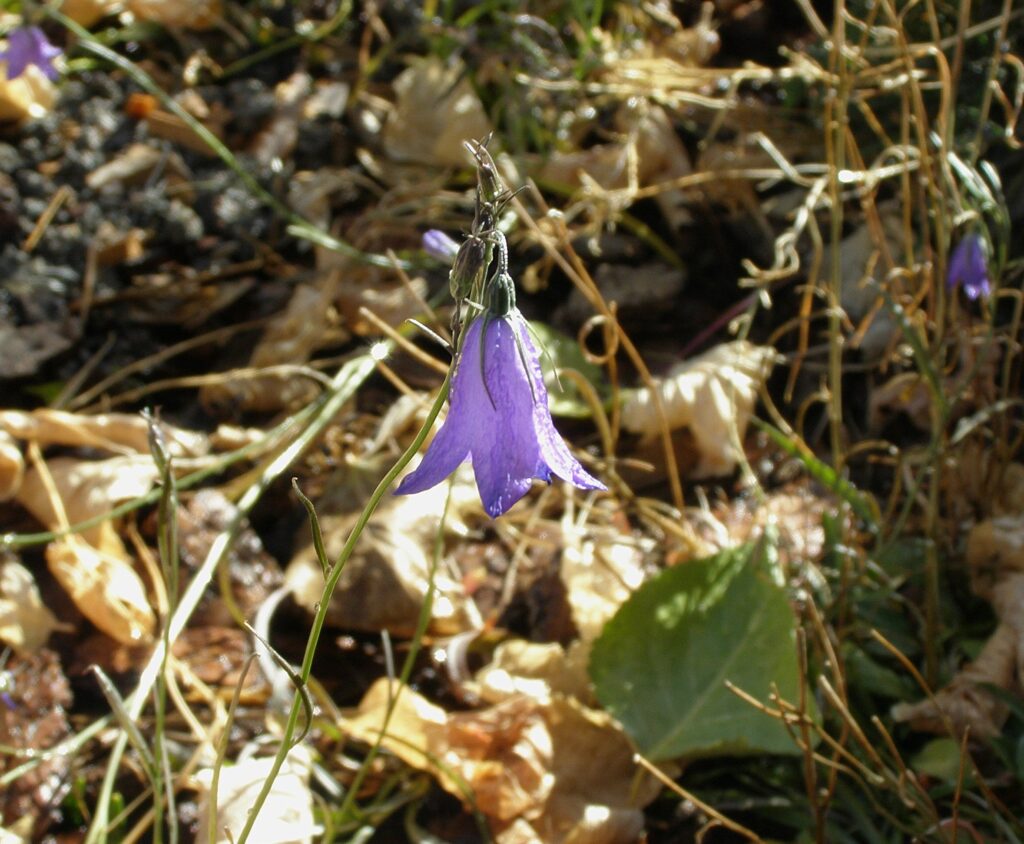Compiled by Karen Vanderwall
This month we thought we would update something we’ve done before and ask our Chapter Board of Directors for nuggets of wisdom from their experience planting natives in their own landscapes—passing on tips, and tricks that will help you establish and enjoy your native garden in the diverse and complex climate of the Front Range.
Peggy

To increase plant volume in your garden, collect ripened seed and spread in the fall. Photo by Linda Hellow.
- Nature is the best propagator. Observe the garden throughout the fall for ripening seed. When ripened, collect and spread seeds to increase your plant volume, or pot them up in the spring to share with friends, community gardens, and local plant swaps. Ask neighbors if you can have some of their seed for plants you’d like to have in your garden. Spread seed just before a rain/snow or cover lightly with soil to avoid their blowing away.
- Design and install walkways before installing plant material in your garden. Also, pay attention to how traffic already flows through the space, as old habits die hard. Pathways ensure you can access all plants and eliminate the chance that plants will be unnecessarily trampled.
- Remember to reduce, redirect or eliminate the drip lines to native plants once they are about three years old. This is especially important if you continue to add plants—the water needs of new plants are different from the older, more established plants.
- When running water from the faucet (waiting for it to get hot), collect it in a vessel you can easily take outdoors to water one of your newly planted natives!
- If you are looking for a splash of red color throughout the season, here are some natives to incorporate into your garden palette:
- Penstemon eatonii
- Penstemon pinifolius
- Penstemon barbatus
- Scrophularia macrantha
- Penstemon rostriflorus
Deb

- “Plant” your water first. In this dry climate, put in swales and dig down, rather than mound up, to keep whatever water we do get from the sky, in your landscape. Swales can direct the water to where you need it.
- Plan for maintenance. Don’t put your very xeric plants next to a tree that needs regular water, e.g., And don’t put your pea gravel mulch right next to a tree that will drop a whole lot of leaves.
- Not all very xeric native plants will do well without water in a very urban environment. I’ve had rabbitbrush die! It’s hotter and drier in the heart of the city, so you have to water some of these plants more than they would need in a non-urban setting. The heat-island effect is real.
- Use the edges around trees. A little bit of shade goes a long way here when it’s hot and dry. My poppy mallow (Callirhoe involucrata), for example, does way better at the edge of a tree, shaded from the hottest part of the day, than it does out in the open.
- Don’t use landscape fabric! The weeds seem to love it. I have said this before, but I have yet to see a yard where landscape fabric has prevented weeds from germinating. At best, it keeps the weeds at bay for a year. At worst, it is starving your soil.
- When buying trees and shrubs, buy the smallest ones you can. In my experience, smaller plants adapt better than larger ones when first planted, and grow better over the long term.
Danna
Danna and John Murgel, horticulturist for Douglas County, discuss cultivars1 vs native species:
Danna: Do cultivars have as much ecosystem benefit as native species? My city plants Rudbeckia and Penstemon cultivars in park garden beds, amongst non-native annuals, as an example of how they are supporting pollinators. I’m wondering if these cultivars have as much benefit, or has that been lost in the breeding? Is there research that compares the benefit to pollinators of common nursery cultivars vs. their native species? I have heard that to native insects, these are like fast food versions of the native species that occur in the wild—but is this actually true? Is there any data?
John Murgel: This one is hard—you simply can’t generalize. Some cultivars might actually be superior to straight-species plants (‘Goldsturm’ Rudbeckia for example, is a sport from straight species but flowers longer and more profusely). Breeding may or may not affect nutrition of pollen or nectar, or amounts produced. You have to evaluate case by case, and for so many cultivars, the research simply has not been done. If a cultivar1 is used, it’s probably safest to go with things that are selections of naturally occurring species rather than with hybrids (which may be sterile, i.e., do not always produce fertile pollen). Perhaps sterile plants have more energy to devote to nectar production though? It becomes complicated quickly. One could make a case for planting non-native plants that benefit honeybees in order to relieve the pressure on the native plants for the native bees. And note, a paper by Baker and Potter in 2020 found that nativar (native plants that have been cultivated) milkweeds were equally good for monarch butterflies and wild bees as straight species wild types.
The generalizations that in my opinion are relatively safe are:
- Avoid doubles, since stamens have been converted into petals in those varieties.
- Plant plants that will make seeds, nativity notwithstanding—you know they’re making pollen and nectar (as applicable) because they have functioning reproductive systems.
- Plant a wide variety of things, because habitat diversity is a better supported indicator of invertebrate diversity, and you’re not putting all your pollinator eggs in one basket of flowers.
Ayn
- Many of us gardeners fall into the trap of over-planting in an effort to get to a ‘finished’ looking garden sooner. The result is that there are too many plants in too little space competing for sun, water, space and visibility and none are able to thrive and show their true beauty. One trick is to cut out paper or cloth circles representing the full diameter of the plant at maturity, and literally lay the circles out before planting to ensure that plant canopies will touch but not overlap when the plants are full grown. This creates the ‘living mulch’ that is ideal for plant health. It takes patience, and likely several years, to wait for the plants to reach full size. Once they do, you can always fill in with low compact plants or ground covers (think fleabane or sulphur buckwheat) if your plant coverage ends up a little thin.
- When you buy (or acquire from the plant swap!) plants for your garden, get the smallest size you can. Small plants will establish more quickly and will outperform larger ones in the long term. Just remember, per tip above, to give them the space to reach their mature size. Once again, patience is required.
- Some plants, even some that are beautiful, can be garden thugs if they like the conditions, spreading by seeds or rhizomes and overtaking their neighbors. Be ruthless! Whack them back or pull some (or even all) of them out. You may conclude that some plants you like are too ‘thuggish’ to fit harmoniously in your landscape, particularly if you’re gardening in a small urban space.
- Learn and use the bare root planting method illustrated on the WOFR website. It really works!
Kristin
- Research and learn each plant’s needs for water, sun, and soil type and plant those with similar needs together. It’s so much easier to give the plants what they need when all the plants in an area desire the same conditions.
- Don’t ignore warnings about a plant being an “aggressive spreader” or “takes over” if you have limited garden space (I’m looking at you, Artemesia ludoviciana.) But if you plant them anyway, you can always remove them later. Of course, some plants are harder to remove than others. (See our article on garden thugs.)
- When you remove turfgrass, especially if you use a sod cutter instead of a smother/lasagna method, be prepared for the weeds. We spent a lot of time pulling out crabgrass, purslane, and spurge the first summer. The weeds popped up all over, but especially right around the newly planted natives that were being watered.
- I find that all my newly planted sun-loving plants greatly benefit from shade cover for their first 6 to 8 weeks. My favorite shade material is burlap, which allows some light and plenty of airflow. I reuse the same burlap year after year and it stores easily.
Kristine

- Plant shrubs and trees first. Trees and shrubs get bigger, cost more, and take more time to become mature. They can impact other plants with their shade, and their shape has a major impact on how plantings look. Native trees and shrubs also have disproportionately large contributions to pollinators and wildlife. Accordingly, place them first. Instead of trying to rush things with expensive, high caliper trees, save money, plant smaller, younger specimens of trees and shrubs, which are more likely to survive and thrive.
- Plant in the fall. While selection can be spotty in the fall, plants may be on discount. The ground is warm and air temperatures are often still quite warm as well, without the overpowering heat of summer. Whatever you plant should be coming with a decent root system, and the plant will focus on growing those roots. They have a better likelihood of survival than things planted in the summer and compare favorably to things planted in the spring.
- Leave the leaves in your flowerbed, but if you have an excess of leaves, make leaf mold. This can be as simple as making a hoop with chicken wire, filling it with leaves, and moistening it periodically.
- Rely on trusted resources to know what to do. I use rubrics like the Xerces Habitat Assessment Guide and the Audubon Habitat Hero program to think about what I should be planting and what my gardening practices should be. I use the planting guides collaboratively put together by CSU Extension, Wild Ones, the Butterfly Pavilion, CoNPS, the High Plains Environmental Center for design inspiration. I reference the Keystone Plant lists from the National Wildlife Federation. I hike and pay attention to what grows where and with whom.
- Map out the micro zones around your house—know where the shade is, know where it’s hot, know which direction the wind comes from in which season, think about high spots and low spots and drainage. I know the area on the south side of my house next to the patio receives full sun and is super hot. I plant my most xeric plants there, and I have a couple of zone-pushing Southern Colorado/Northern New Mexico things there. On the north side of my house, I have an (ill-advised) aspen, whose roots will stay cooler and moister in its shadier spot. In my super shady side yard, I have columbines, nodding onion, snowberries, and serviceberries.
- A “cultivar” is a cultivated variation of a plant bred by humans selecting for certain desirable traits such as color, size, growth habit, longer bloom time, disease resistance. Some cultivars do not produce seed or are sterile. A cultivar can be derived from native or non-native species. “Hybrids” are created by cross-breeding two or more entirely different species. Hybrids occur both in nature and through breeding by humans, and often have an X in their name. Hybrids can be a combination of native or non-native plants. Often a cultivar or hybrid derived from native species is called a “nativar.” ↩︎
Vicki
Once you’ve implemented all these great tips and tricks, what’s next? Sit back and enjoy your garden! For some great suggestions on how to really tune into your landscape, see our Remember the Five Senses article.
